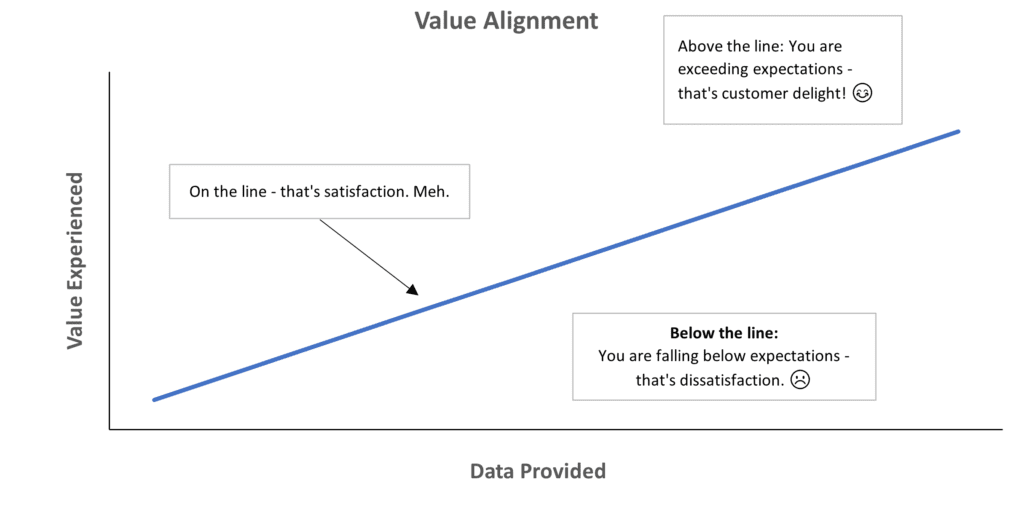Last year, I wrote a blog post that discussed the value of first-party data versus authenticated audiences. If you did not have a chance to read it, here are the key takeaways:
- First-party data is a general term that describes data your organization has collected about your audience.
- An authenticated audience is a group of users that have completed a validation process (e.g. some sort of log-in process in the digital world).
- Authenticated data is the most valuable type of first-party data because it contains personally identifiable information (PII) that allows marketers to more effectively reach and appeal to an individual.
While 2021 was focusing on surfacing and building a business case around the topic, the rest of 2022 should be the time to act with the primary goals of obtaining more authenticated first-party data, as well as reducing the likelihood that people will withdraw their consent. This is especially critical as data privacy regulations increase and become more pervasive.
If you are starting to employ initiatives to capture authenticated data – awesome! But what if you want to get the most out of that e-book you’re publishing to capture prospects? What about that custom app you built in order to get more information on your customers’ interests? Or maybe you want to get newsletter subscribers to share more of their personal information?
Below you will find a framework for thinking about and activating on how to capture and keep authenticated first-party data. Expect future posts that address how to measure and begin optimizing on this framework – the key to this post is that it will set a foundation for moving forward.
Consumers Expect Value in Exchange for Their Data
The key to capturing authenticated first-party data is to create value. We have seen multiple data points over the past few years providing evidence of consumers putting more value on their personal data, such as this study by the Pew Research Center. We have also seen some organizations try to capitalize on this, such as Apple and their evolution of their Intelligent Tracking Prevention (ITP) service.
Research has also revealed that people are starting to attach a dollar value to the information they share with an organization. For instance, one research study from the Journal of Consumer Policy found that consumers would want $80 per month for access to their personal data (according to the study, this value goes higher if health-related information was included).
What is important here isn’t the exact dollar amount from that study. After all, the value that a person puts on their personal data likely varies based on a number of factors, such as what information they are being asked to share (e.g. email vs. a phone number), familiarity with a brand (e.g. have they been a loyal customer for a long time where trust has been built), and the context in which they are sharing (are they sharing as a consumer or part of their job?).
What is important is this: if a person shares their personal information with you, they are sharing something of value, and in return, they should receive something of value back.

This isn’t really a new or complex concept, but quite often, the notion of value creation for personal data is not something that makes it on the priority list for many organizations. For instance, I know of one company that, until last year, had an account mechanism on their website. While it was a great opportunity to capture first-party data, they removed it was because no one was using it. Taking a step back and asking whether the account feature was offering value to their customers likely would have resulted in a different outcome – one where they instead revamped the account experience in a way that was valuable for users and the organization.
And that’s where this next model becomes really important.
Value Alignment – Are You Delighting Your Customers?
It’s a simple question to ask: based on what you are asking people to share with you, are you providing something that is equal, or preferably better, in return?
Consider the following chart below, which is designed to show the relationship between two key variables associated with aligning value between people and organizations:
- Data Provided: The amount of personal data that a person is being asked to share
- Value Experienced: The perceived value gained from sharing personal data
Take a moment and really note the point about ‘perceived value’ – perceptions are the key here as they drive behavior. As an organization, you can think that you are offering value, but sorry, it doesn’t matter what you think – it matters what the people sharing their data think.

The ultimate goal for an organization is customer delight – this is when expectations are exceeded based on the amount of data shared. When a person is delighted, they are less likely to remove their consent and increase the amount of data shared with you. If expectations fall below the line (such as in the example mentioned above), that’s when the opposite happens and churn rates increase.
Of course, there is nothing inherently wrong with creating a satisfied customer, so if you are meeting expectations, there are positives in that. But ask this question of yourself: do you want to be satisfied in life or do you want to be delighted?
The Next Step
There’s a lot of work to do to prepare your organization to meet evolving consumer needs. Now you have a framework and foundation to help you start working from when it comes to capturing authenticated first-party data. The next step is to start quantifying the value that people attach to their personal data and whether the experiences you are offering them in exchange are exceeding or falling below what they are providing.
Now that’s a dynamic measurement challenge. And one we will address in a future blog post, so stay tuned!
















